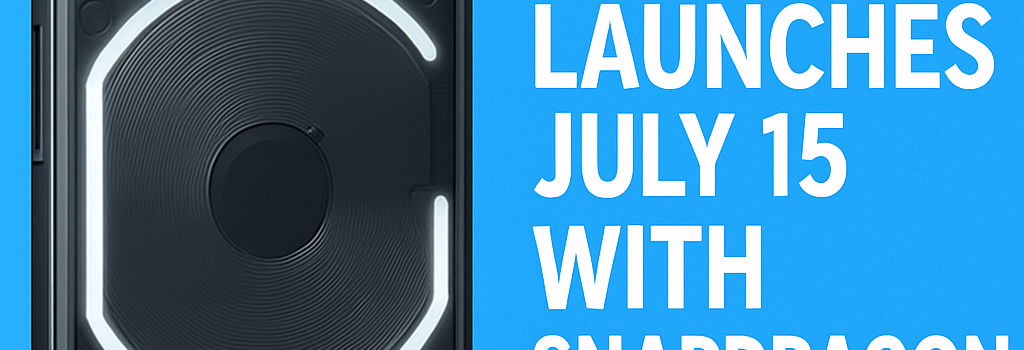Nothing Phone 3 Launches July 15 with Snapdragon 8s Gen 4

Carl Pei’s Nothing is back in the flagship arena with the Nothing Phone 3, officially launching on July 15. Priced at $799 for the base model, the Phone 3 sits squarely in the premium segment, offering a unique blend of quirky design flourishes and competitive hardware. While it doesn’t claim the absolute top-tier silicon, the Snapdragon 8s Gen 4 platform, 6.67-inch 120 Hz OLED, and robust camera array deliver compelling value against peers from Samsung, OnePlus, and Apple.
Design Evolution and the New Glyph Matrix
Gone are the full-length Glyph LED strips of earlier Nothing phones; in their place sits a 47×17-pixel dot matrix display dubbed the Glyph Matrix. Located on the rear upper right, this monochrome LED panel handles custom notification icons, low-res animations, retro games, and even acts as a low-fi “selfie mirror” when facing front.
- Dedicated back button to toggle Glyph Matrix modes
- Customizable patterns via Nothing OS’s Theme app
- Power draw under 30 mW in idle to preserve battery life
Display and Industrial Design
The Phone 3 retains Nothing’s signature transparent glass back, exposed mid-frame rails, and hex screws. At 7.5 mm thick (18% slimmer than Phone 2), it has uniform 1.87 mm bezels framing a 6.67-inch AMOLED panel. Key display specs:
- 120 Hz adaptive refresh rate (1 Hz–120 Hz)
- Peak brightness up to 4,500 nits (HDR boosts included)
- 10-bit color, 2,400×1,080 pixel resolution, 1,000,000:1 contrast
- Corning Gorilla Glass Victus 2 front protection
Performance Deep Dive
At its heart, the Phone 3 runs on the Snapdragon 8s Gen 4. Positioned below Qualcomm’s flagship 8 Gen 3 and upcoming Elite series, this 4 nm chip delivers:
CPU and GPU Architecture
• “Kryo Prime” core @ 3.2 GHz (Cortex-X4 derivative)
• Three performance “Gold” cores @ 2.8 GHz
• Four efficiency “Silver” cores @ 2.0 GHz
• Adreno 754 GPU (15% slower than 8 Gen 3’s 765, but 20% faster than Gen 2)
Memory and Storage Options
• 12 GB / 16 GB LPDDR5X RAM
• 256 GB / 512 GB UFS 4.0 storage
• Faster random read/write and improved power efficiency vs. UFS 3.1
Camera System Breakdown
Nothing’s four-camera layout sports three 50 MP sensors on the back and a 50 MP selfie unit. Hardware highlights:
- Primary: 1/1.3″ Samsung GN5 with f/1.6 aperture, OIS
- Ultrawide: f/2.2, 114° field, macro autofocus
- Telephoto: 3× optical zoom, f/2.4
- Selfie: 1/2.5″ sensor, f/2.0, portrait depth mapping
Despite strong optics, image signal processing remains critical. Early hands-on reviews note improved HDR and low-light clarity via Nothing’s updated ISP tuning, though color consistency could edge closer to Pixel-level output.
Battery, Charging, and Thermal Management
Charge Speeds and Efficiency
The 5,150 mAh battery not only exceeds the 5,000 mAh class average, but it supports:
- 65 W wired (USB Power Delivery 3.1 PPS)
- 15 W Qi2 wireless charging
- 5 W reverse wireless for accessories
Thermal imaging tests reveal robust heat dissipation via a graphene composite layer and dual vapor chambers, keeping sustained loads 3–5 °C cooler than unshielded designs.
Software, AI Integration, and Updates
Nothing OS 3.5, built on Android 15, preserves the minimalist UI and custom Glyph controls. Key features:
- Essential Key button: Launches Essential Space, an AI-powered hub that organizes notes, screenshots, and generates action items using an on-device large language model.
- Dedicated camera shutter and video mode toggles via physical side buttons.
- Upcoming Android 16 upgrade (H2 2025) promised alongside five years of OS updates and two years of security patches.
“Nothing’s OS strikes a balance between flexibility and simplicity, and the Essential Space is one of the more innovative ‘AI assistant’ implementations we’ve tested,” says mobile software expert Dr. Elena Martinez.
Network Compatibility and US Launch
For the first time, Nothing provides full US carrier support. The Phone 3 works on:
- T-Mobile and AT&T: Sub-6 and mmWave 5G
- Verizon: Sub-6 only (limited mmWave)
Global preorders start July 4; US availability on July 15. Two SKUs:
- $799 – 12 GB RAM / 256 GB storage
- $899 – 16 GB RAM / 512 GB storage
Price, Availability, and Market Position
- Comparative: $799 vs. Galaxy S23 ($799), OnePlus 11 ($699), Pixel 8 ($699).
- Value: Above midrange pricing, below ultra-flagship territory.
Value Proposition
At $799, the Phone 3 undercuts many flagship rivals by $100–$200, trading minor GPU peaks for standout design and fast charging.
Industry Impact and Future Outlook
By integrating a programmable dot matrix and deep AI tools, Nothing continues to push smartphone UI innovation. Analysts expect Nothing to explore foldable hardware next, possibly partnering with Google for deeper Tensor-chip AI co-processing.
What’s Next?
Rumors hint at a Flip variant in 2026, and Carl Pei has teased a bespoke SoC initiative for 2027 to optimize AI workloads on-device.